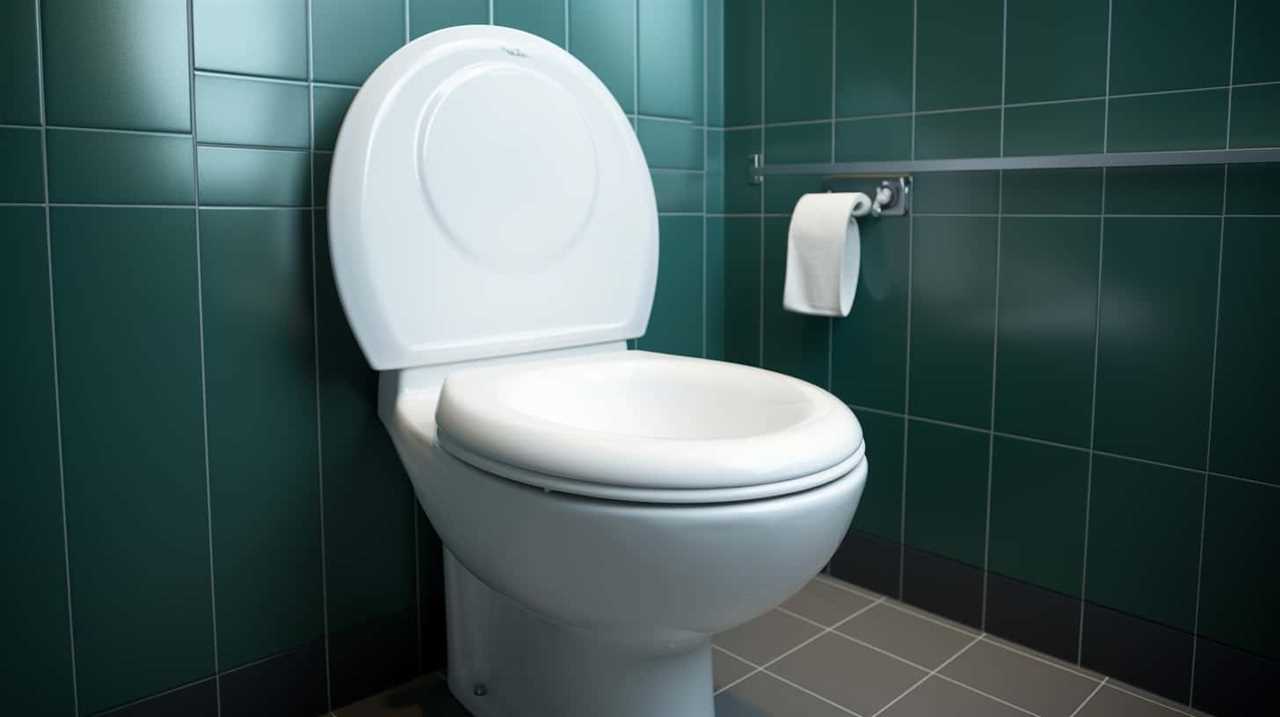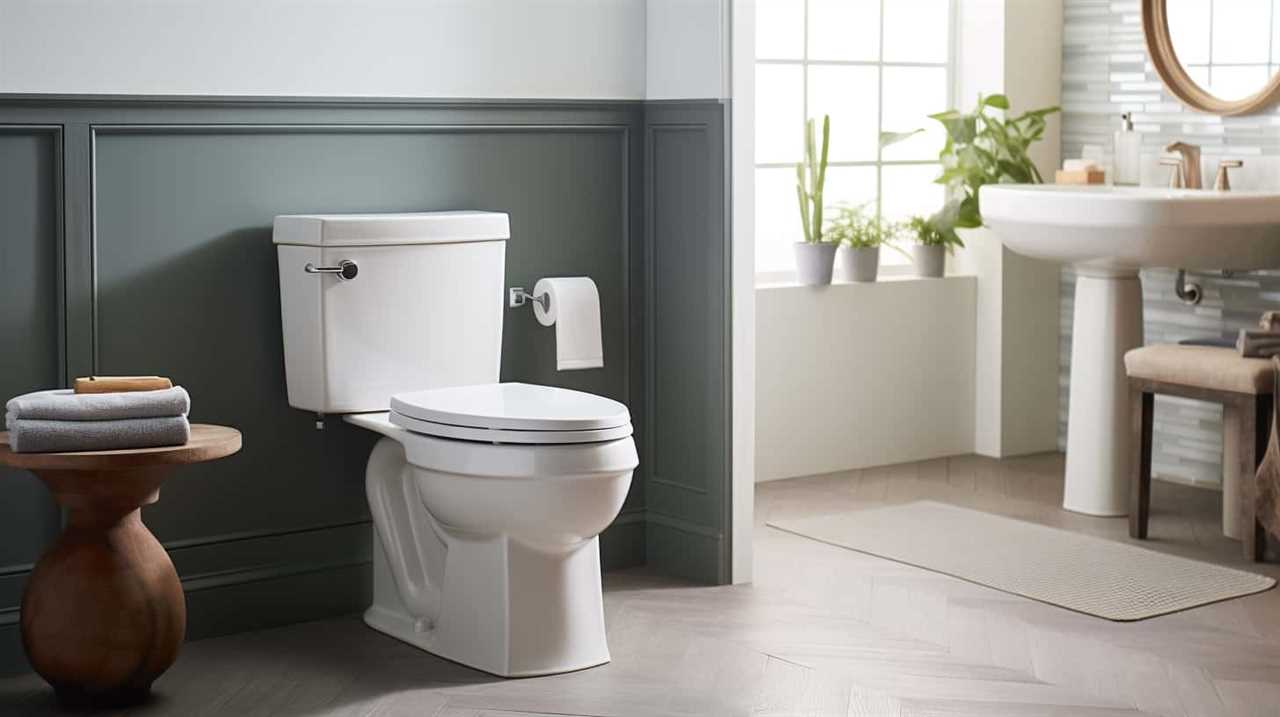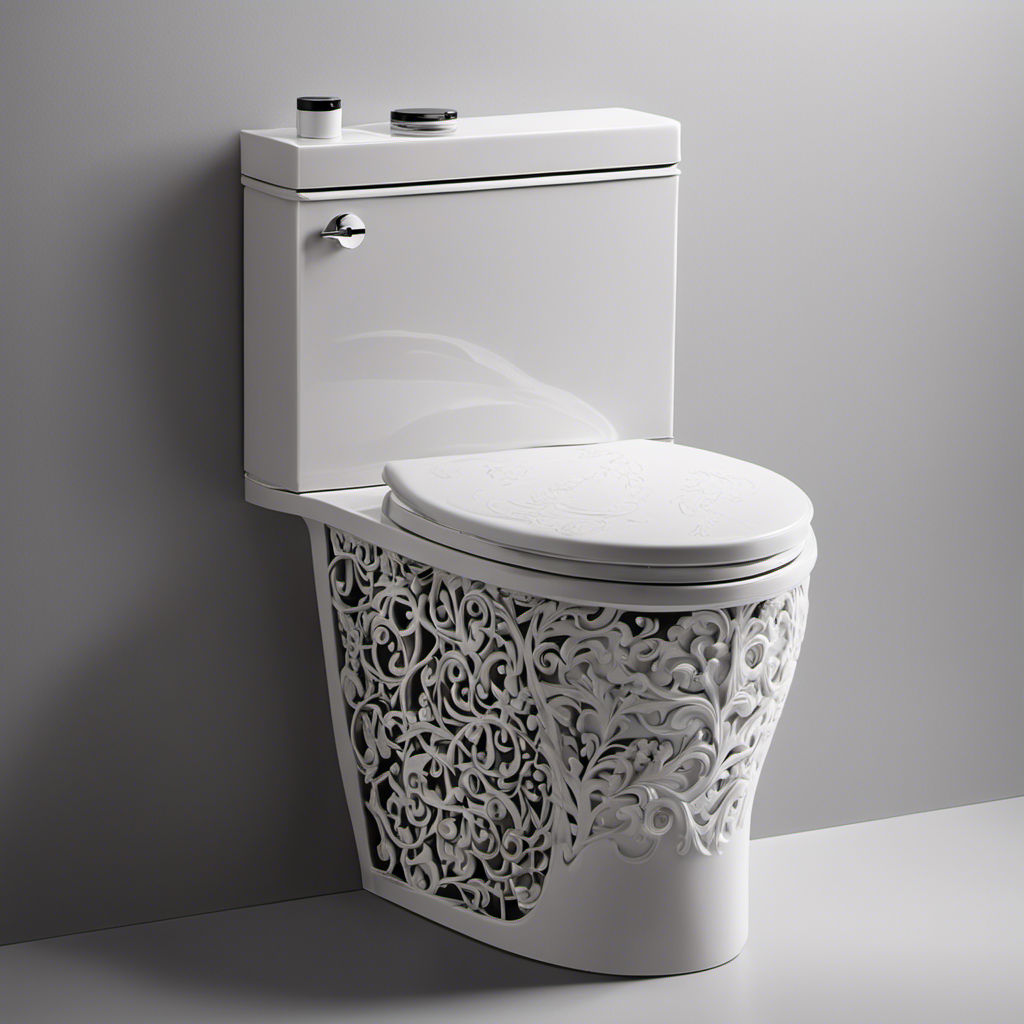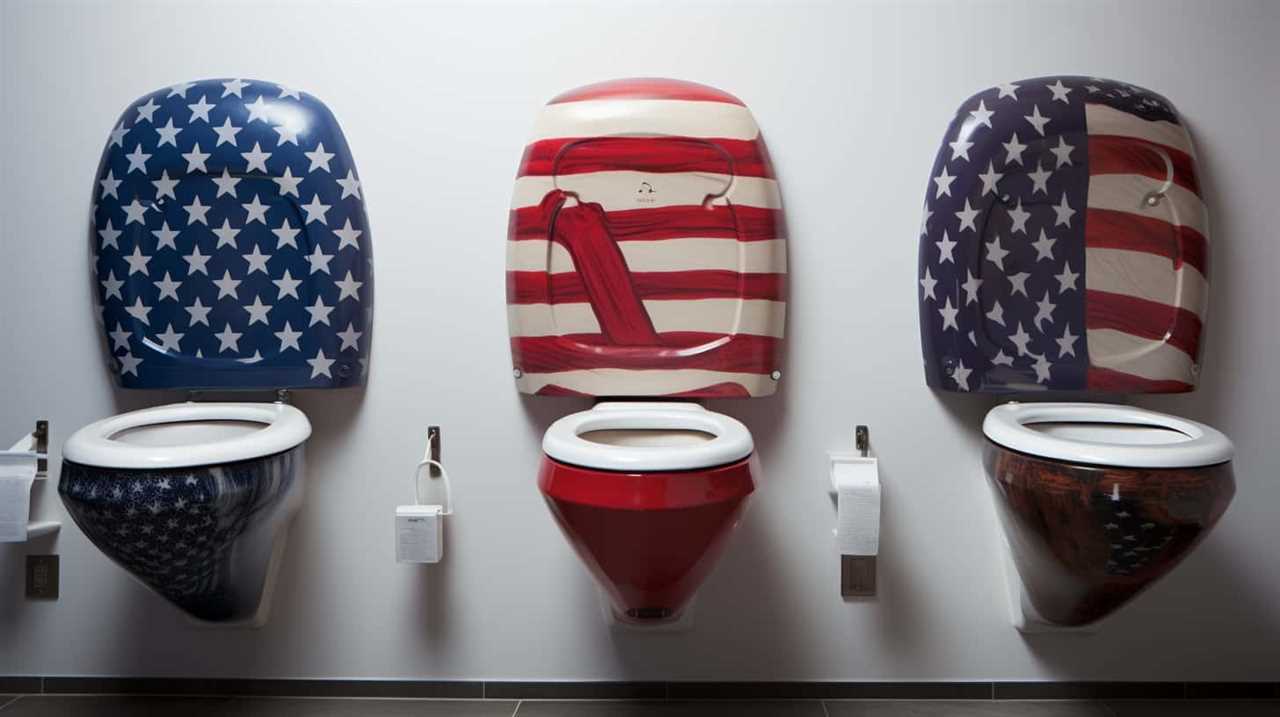Have you ever found yourself bewildered and aggrieved by a toilet that just won’t flush post-use? That moment of sudden anxiety and feeling of being stuck is something we’ve all gone through.
But fear not, as we delve into the common culprits behind this predicament. From clogged toilet bowls to faulty valves, we’ll explore the possible causes and solutions for your flushing woes.
Get ready to master the art of troubleshooting your toilet, as we uncover the secrets to a smoothly functioning bathroom fixture.
Key Takeaways
- Clogged Toilet Bowl: Use a plunger or toilet auger to dislodge clogs.
- Insufficient Water in the Tank: Check and adjust the water level to ensure proper flush force.
- Faulty Flapper Valve: Replace or maintain the flapper valve to ensure proper water flow during flush.
- Blocked or Damaged Sewer Line: Address sewer line issues promptly and contact a professional plumber if needed.
Clogged Toilet Bowl
After using the toilet, we may sometimes encounter a clogged toilet bowl due to various reasons. One common tool to address this issue is a toilet plunger. With its rubber cup at one end, a plunger creates suction to dislodge the clog.

To use it effectively, place the cup over the drain hole and push down firmly, then pull up quickly. Repeat this motion until the water starts to drain.
If the plunger fails to clear the clog, a toilet auger might be necessary. This tool has a long, flexible cable that can navigate through the pipes to break up stubborn clogs. It’s inserted into the bowl and rotated to dislodge the blockage.
Now, let’s move on to the next section and discuss the potential issue of insufficient water in the tank.
Insufficient Water in the Tank
To address the issue of insufficient water in the tank, we need to check the water level and adjust it if necessary. The water level in the toilet tank plays a crucial role in ensuring a proper flush. If the water level is too low, it may not provide enough force to push the waste down the drain. On the other hand, if the water level is too high, it may overflow when flushed. To check the water level, remove the tank lid and look for a mark or line indicating the correct water level. If the water level is below the mark, adjust the float valve or fill valve to increase the water level. If it’s above the mark, adjust the float valve or fill valve to decrease the water level. Maintaining the correct water level in the toilet tank is essential for a fully functioning flush.

| Issue | Cause | Solution |
|---|---|---|
| Insufficient water in the tank | Water level too low | Adjust float valve or fill valve to increase the water level |
| Water level too high | Adjust float valve or fill valve to decrease the water level |
Now that we have addressed the issue of insufficient water in the tank, let’s move on to the next possible cause of a toilet not flushing properly: a faulty flapper valve.
Faulty Flapper Valve
The most common cause for a toilet not flushing properly is a malfunctioning flapper valve. The flapper valve is responsible for controlling the flow of water from the tank into the bowl during a flush. Over time, the flapper valve can become worn or damaged, resulting in leaks or inadequate flushing.
To fix this issue, you may need to replace the flapper valve. Flapper valve replacement is a relatively simple process that involves shutting off the water supply, removing the old flapper valve, and installing a new one.
Regular flapper valve maintenance is also important to prevent future problems. This includes checking for any signs of wear or damage and cleaning the valve as needed.

Blocked or Damaged Sewer Line
We may experience a blockage or damage in the sewer line, which can prevent our toilet from flushing properly. Signs of a blocked sewer line include slow draining sinks, gurgling noises in pipes, foul odors, and water backups in toilets or drains.
If we suspect a blocked or damaged sewer line, it’s important to address the issue promptly to avoid further damage and potential health hazards. In some cases, a sewer line replacement may be necessary to resolve the problem.
It’s recommended to contact a professional plumber who specializes in sewer line repairs and replacements. They’ll be able to assess the situation, identify the underlying cause, and provide the appropriate solution to ensure our toilet can flush properly again.
Malfunctioning Fill Valve
After using the toilet, if our toilet won’t flush, it could be due to a malfunctioning fill valve. The fill valve is responsible for refilling the toilet tank with water after each flush. If it malfunctions, it may not allow enough water to enter the tank, resulting in a weak or incomplete flush. To troubleshoot this issue, we can perform a few simple toilet repair steps. First, check the water level in the tank and adjust the fill valve if necessary. Additionally, inspect the fill valve for any blockages or damages that may be impeding its proper functioning. If needed, replace the fill valve with a new one. By following these troubleshooting tips, we can ensure our toilet flushes properly.

| Possible Causes | Troubleshooting Tips |
|---|---|
| Fill valve blockage | Clean or replace fill valve |
| Damaged fill valve | Replace fill valve |
| Incorrect water level | Adjust fill valve |
| Insufficient water supply | Check water supply and pressure |
Low Water Pressure
To continue troubleshooting why our toilet won’t flush after use, another possible cause could be low water pressure in the fill valve. Low water pressure can hinder the proper functioning of the flush mechanism, resulting in a weak or incomplete flush.
Here are some potential solutions for troubleshooting low water pressure in the fill valve:
- Check the water supply: Ensure that the main water supply is fully open and providing adequate pressure to the fill valve.
- Clean the fill valve: Sediment or debris may accumulate in the fill valve, obstructing the water flow. Clean the valve to remove any blockages.
- Adjust the fill valve: Some fill valves have adjustable settings. Check the manufacturer’s instructions to adjust the valve to the appropriate water pressure.
Improperly Adjusted Flush Handle
If your toilet won’t flush after use, one possible reason could be an improperly adjusted flush handle. This can happen if the handle is loose or stuck.
A loose handle may not properly engage the flushing mechanism, while a stuck handle may prevent the flushing mechanism from working altogether.

Loose Flush Handle
To ensure a properly functioning toilet, we need to address the issue of a loose flush handle. A loose flush handle can cause the toilet to not flush properly or even not flush at all.
Here are some troubleshooting steps for toilet handle repair:
- Check the connection: Make sure the flush handle is securely attached to the toilet tank lever. If it’s loose, tighten the nut or screw that holds it in place.
- Adjust the chain length: If the chain connecting the flush handle to the flapper is too long or too short, it can cause issues. Adjust the chain length so that there’s a slight slack when the handle is at rest.
- Replace the handle: If the handle is damaged or worn out, it may need to be replaced. Look for a compatible handle and follow the manufacturer’s instructions for installation.
Stuck Flush Handle
We often encounter a common problem with toilets where the flush handle gets stuck, preventing proper flushing. One possible cause of a stuck flush handle is a loose chain or a broken lever.
When the chain connecting the flush handle to the flapper valve is loose, it can get tangled or caught, preventing the flush mechanism from working properly. Similarly, a broken lever can also result in a stuck flush handle.

To fix this issue, start by checking the chain and making sure it’s properly connected and not too loose. If the chain is intact, examine the lever to see if it’s broken or damaged. If necessary, replace the chain or lever to restore proper functioning to the flush handle.
Leaking or Damaged Flush Valve
Sometimes, our toilets refuse to flush after use because the flush valve is leaking or damaged. When this happens, it’s important to address the issue promptly to ensure proper toilet functionality.
Here are a few reasons why your toilet’s flush valve may be causing flushing problems:
- Worn out seal: Over time, the rubber seal that prevents water from leaking out of the tank can deteriorate, leading to leaks. Regular toilet maintenance, such as inspecting and replacing worn-out seals, can help prevent this issue.
- Cracked or broken valve: A damaged flush valve can also cause leaks, preventing proper flushing. If you notice any cracks or breakage in the valve, it may need to be replaced.
- Improper installation: Incorrect installation of the flush valve can result in leaks. Double-check the installation instructions and ensure that the valve is properly aligned and tightened.
Defective or Worn-Out Toilet Parts
As we address the issue of why your toilet won’t flush after use, it’s important to consider the possibility of defective or worn-out toilet parts.

The toilet tank and toilet bowl are comprised of various components that can deteriorate over time. One common culprit is a faulty flapper valve. This rubber seal is responsible for releasing water from the tank into the bowl during the flushing process. If it becomes worn or damaged, it may not create a proper seal, leading to a weak or incomplete flush.
Another potential problem is a malfunctioning fill valve. This valve controls the water level in the tank and if it fails, it can result in inadequate water supply for a proper flush.
Additionally, the handle and chain mechanism may wear out, causing issues with flushing.
If you suspect any of these parts to be defective or worn-out, it’s advisable to consult a professional plumber for repair or replacement.

Frequently Asked Questions
How Can I Fix a Leaking or Damaged Flush Valve?
To fix a leaking or damaged flush valve, we need to first locate the toilet tank. Then, we can turn off the water supply by shutting the valve. Next, we should remove the toilet handle and replace the flush valve.
What Should I Do if My Toilet Has Low Water Pressure?
When our toilet has low water pressure, we feel frustrated and inconvenienced. Luckily, there are solutions to address toilet water pressure problems. Let us guide you through the steps to fix it.
Are There Any Troubleshooting Steps for a Malfunctioning Fill Valve?
When troubleshooting a malfunctioning fill valve, there are several steps you can take to fix it. First, check for any clogs or debris that may be causing the issue. Then, ensure that the water supply is properly connected and turned on. If necessary, adjust the float or replace the fill valve altogether.
Can a Defective or Worn-Out Toilet Part Cause Flushing Issues?
Yes, a defective or worn-out toilet part can cause common toilet flushing problems. It’s frustrating when the toilet tank problems prevent us from flushing after use, but we can troubleshoot and replace the faulty part to fix the issue.

How Can I Determine if My Toilet Has a Blocked or Damaged Sewer Line?
To determine if our toilet has a blocked or damaged sewer line, we can look for signs such as recurring clogs, slow draining, gurgling sounds, and sewage backup. Professional assistance may be necessary for accurate toilet clog detection and sewer line assessment.
Conclusion
In conclusion, a clogged toilet bowl, insufficient water in the tank, faulty flapper valve, blocked or damaged sewer line, malfunctioning fill valve, low water pressure, improperly adjusted flush handle, leaking or damaged flush valve, and defective or worn-out toilet parts can all cause a toilet to not flush properly.
According to a recent study, approximately 30% of toilet flush issues are caused by clogged toilet bowls, highlighting the importance of regular maintenance to ensure proper functionality.










